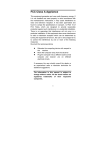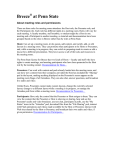Download Moxa PT-7324-R-HV network switch
Transcript
Moxa PowerTrans Switch PT-7324 Series User’s Manual www.moxa.com/product First Edition, January 2008 © 2008 Moxa Inc., all rights reserved. Reproduction without permission is prohibited. Moxa PowerTrans Switch PT-7324 Series User’s Manual The software described in this manual is furnished under a license agreement and may be used only in accordance with the terms of that agreement. Copyright Notice Copyright © 2008 Moxa Inc. All rights reserved. Reproduction without permission is prohibited. Trademarks MOXA is a registered trademark of Moxa Inc. All other trademarks or registered marks in this manual belong to their respective manufacturers. Disclaimer Information in this document is subject to change without notice and does not represent a commitment on the part of Moxa. Moxa provides this document “as is,” without warranty of any kind, either expressed or implied, including, but not limited to, its particular purpose. Moxa reserves the right to make improvements and/or changes to this manual, or to the products and/or the programs described in this manual, at any time. Information provided in this manual is intended to be accurate and reliable. However, Moxa assumes no responsibility for its use, or for any infringements on the rights of third parties that may result from its use. This product might include unintentional technical or typographical errors. Changes are periodically made to the information herein to correct such errors, and these changes are incorporated into new editions of the publication. Technical Support Contact Information www.moxa.com/support Moxa Americas: Toll-free: 1-888-669-2872 Tel: +1-714-528-6777 Fax: +1-714-528-6778 Moxa China (Shanghai office): Toll-free: 800-820-5036 Tel: +86-21-5258-9955 Fax: +86-10-6872-3958 Moxa Europe: Tel: +49-89-3 70 03 99-0 Fax: +49-89-3 70 03 99-99 Moxa Asia-Pacific: Tel: +886-2-8919-1230 Fax: +886-2-8919-1231 Table of Contents Chapter 1 Introduction ...............................................................................................1-1 Overview .............................................................................................................................. 1-2 Package Checklist................................................................................................................. 1-2 Features ................................................................................................................................ 1-2 Chapter 2 Getting Started ..........................................................................................2-1 RS-232 Console Configuration (115200, None, 8, 1, VT100) ............................................. 2-2 Configuration Using a Web Browser.................................................................................... 2-4 Chapter 3 Featured Functions ...................................................................................3-1 Configuring Basic Settings................................................................................................... 3-2 Port ............................................................................................................................ 3-2 Network..................................................................................................................... 3-3 Password ................................................................................................................... 3-4 System File Update ................................................................................................... 3-5 Local Import/Export.................................................................................................. 3-6 Restart ....................................................................................................................... 3-6 Factory Default.......................................................................................................... 3-6 Using Bandwidth Management ............................................................................................ 3-7 Broadcast Strom Protection....................................................................................... 3-7 Configuring Traffic Rate Limiting ............................................................................ 3-7 Using Traffic Prioritization................................................................................................... 3-8 The Traffic Prioritization Concept ............................................................................ 3-8 Configuring Traffic Prioritization ........................................................................... 3-11 Using Virtual LAN ............................................................................................................. 3-12 The Virtual LAN (VLAN) Concept ........................................................................ 3-12 Using Virtual LANs ................................................................................................ 3-13 Using Auto Warning ........................................................................................................... 3-14 Configuring Relay Warning .................................................................................... 3-15 Relay Warning Events Settings............................................................................... 3-15 Using the Monitor............................................................................................................... 3-16 Monitor Port Link Status......................................................................................... 3-16 Monitor by Switch................................................................................................... 3-17 Chapter 4 PT-7324 Configurator GUI ........................................................................4-1 Starting PT-7324 Configurator ............................................................................................. 4-2 Broadcast Search .................................................................................................................. 4-2 Search by IP address............................................................................................................. 4-3 Modify IP Address................................................................................................................ 4-3 Export Configuration............................................................................................................ 4-4 Import Configuration............................................................................................................ 4-5 Unlock Server....................................................................................................................... 4-6 Appendix A Specifications ........................................................................................... A-1 1 Chapter 1 Introduction Welcome to the Moxa PowerTrans Switch PT-7324 Series, the rack-mount Smart Ethernet Switch designed especially for connecting Ethernet-enabled devices in industrial field applications. The following topics are covered in this chapter: Overview Package Checklist Features PT-7324 Series User’s Manual Introduction Overview Reliable network operation is a must for many applications, including Power Automation and Transportation Automation. Network equipment must be protected against electrical surges and EMI, extreme temperature variations, and other environmental threats. The Moxa PowerTrans series is designed to meet the demands of power substation automation systems (IEC 61850-3, IEEE 1613), traffic control systems (NEMA TS 2), and railway applications (EN50121-4). In addition to a rugged hardware design for critical environments, the PowerTrans PT-7324 Smart Ethernet Switch is also equipped with “smart” features, “Class of Service” features suitable for multimedia applications, and port-based VLAN features that can be used to segment your network without being restricted by physical connections. If you do not want to receive too many broadcast packets, the broadcast storm filtering feature will discard broadcast packets if the number of such packets exceed a threshold in a preset period of time. Package Checklist Each Moxa PT-7324 Series switch is shipped with the following items: y 1 Moxa PowerTrans Switch y Hardware Installation Guide y CD-ROM with User’s Manual and Windows Utility y Moxa Product Warranty Statement y RJ45 to DB9 Console port cable y Protective caps for unused ports y Two rack-mount ears NOTE: Please notify your sales representative if any of the above items are missing or damaged. Features High Performance Network Switching Technology y Port-based VLAN to ease network planning y 802.1p priority queues and port-based QoS to increase determinism y Broadcast storm filtering Designed for Industrial Applications y One slot for optional network modules: > One 2-port Gigabit module, with 10/100/1000BaseT(X) (RJ45 connector), or 1000BaseSX/LX/LHX/ZX (SFP slot, LC connector) > Six 2- or 1-port Fast Ethernet modules with a combination of 10/100BaseT(X) (RJ45 connector) and 100BaseFX (Single/Multimode, SC/ST connector) y IP30, rugged high-strength case y Rackmounting capability 1-2 2 Chapter 2 Getting Started In this chapter, we explain how to access your Moxa PowerTrans Switch for the first time. There are two ways to access the switch: by serial console or web browser. The serial console connection method, which requires using a short serial cable to connect the switch to a PC’s COM port, can be used if you do not know the switch’s IP address. The web browser connection method can be used to access Moxa PowerTrans Switches over an Ethernet LAN, or over the Internet. The following topics are covered: RS-232 Console Configuration (115200, None, 8, 1, VT100) Configuration Using a Web Browser PT-7324 Series User’s Manual Getting Started RS-232 Console Configuration (115200, None, 8, 1, VT100) NOTE Connection Caution! 1. You can connect to the PT-7324 using a web browser and serial console simultaneously. 2. Recommendation—when connecting to the PT-7324 using a web browser, do NOT simultaneously connect using the serial console. By following this advice, you can maintain better control over how your Moxa PowerTrans Switch is managed. NOTE We recommend using Moxa PComm Terminal Emulator, which can be downloaded free of charge from Moxa’s website. Before running PComm Terminal Emulator, use an RJ45 to DB9-F (or RJ45 to DB25-F) cable to connect the PT switch’s RS-232 console port to your PC’s COM port (generally COM1 or COM2, depending on how your system is set up). After installing PComm Terminal Emulator, follow the steps given below to access the RS-232 Console utility. 1. From the Windows desktop, click Start Æ Programs Æ PCommLite2.5 Æ Terminal Emulator. 2. Select Open under Port Manager to open a new connection. 2-2 PT-7324 Series User’s Manual Getting Started 3. The Communication Parameter page of the Property window opens. Select the appropriate COM port for Console Connection, 115200 for Baud Rate, 8 for Data Bits, None for Parity, and 1 for Stop Bits. 4. Click the Terminal tab, and select VT100 for Terminal Type. Click OK to confirm. 5. Press Enter. The Console login screen will be displayed. Type admin in the Account field and use the keyboard’s down arrow to move the cursor to the Password field, enter the Password, and then press Enter. Note that this password is the same as the Web Browser password; leave the Password field blank if a console password has not been set. 6. The PT-7324’s Main Menu will be displayed. (NOTE: To modify the appearance of the PComm Terminal Emulator window, select Font… under the Edit menu, and then choose the desired formatting options.) 2-3 PT-7324 Series User’s Manual 7. Getting Started Press 1 to modify the PT-7324’s network parameters, or press 2 to reset the PT switch’s configuration to the factory defaults. Configuration Using a Web Browser The PT-7324’s web browser interface provides a convenient way to modify the switch’s configuration and access the built-in monitoring and network administration functions. The recommended web browser is Microsoft Internet Explorer 5.5 or 6.0 with JVM (Java Virtual Machine) installed. NOTE To use the PT-7324’s management and monitoring functions from a PC host connected to the same LAN as the PT-7324, you must make sure that the PC host and the PT-7324 are on the same logical sub network. NOTE Before accessing the PT-7324’s web browser interface, first connect one of the PT-7324’s RJ45 Ethernet ports to your Ethernet LAN, or directly to your PC’s Ethernet NIC. You can establish a connection with either a straight-through or cross-over Ethernet cable. If you have difficulty connecting, refer to the Auto MDI/MDI-X Connection section from the Hardware installation Guide for more information about the different types of Ethernet cables and ports. NOTE The PT-7324’s default IP is 192.168.127.253. Perform the following steps to access the PT-7324’s web browser interface. 1. Open Internet Explorer and type the PT-7324’s IP address in the Address field. Press Enter to establish the connection. 2. The web login page will be displayed. Select the login account (Admin or User) and enter the Password (this is the same as the Console password), and then click Login to continue. Leave the Password field blank if a password has not been set. 2-4 PT-7324 Series User’s Manual NOTE Getting Started By default, the PT-7324’s Password is not set (i.e., is blank). You may need to wait a few moments for the web page to be downloaded to your computer. Use the menu tree on the left side of the window to open the function pages to access each of the PT-7324’s functions. 2-5 3 Chapter 3 Featured Functions This chapter explains how to access a Moxa PowerTrans Switch’s various configuration, monitoring, and administration functions. There are two ways to access these functions: serial console and web browser. The serial console connection method, which requires using a short serial cable to connect the PT-7324 to a PC’s COM port, can be used if you do not know the PT-7324’s IP address. The Telnet console and web browser connection methods can be used to access the PT-7324 over an Ethernet LAN, or over the Internet. The Web Console is the most user-friendly way to configure your PT-7324. In this chapter, we use the Web Console interface to introduce the PT-7324’s functions. There are only a few differences between the Web Console, Serial Console, and Telnet Console access methods. The following topics are covered in this chapter: Configuring Basic Settings Using Bandwidth Management Using Traffic Prioritization Using Virtual LAN Using Auto Warning Using the Monitor PT-7324 Series User’s Manual Featured Functions Configuring Basic Settings The Basic Settings group includes the most commonly used settings required by administrators to maintain and control the PT-7324. Port Port settings are included to give the user control over Port Access, Port Transmission Speed, Flow Control, and Port Type (MDI or MDIX). An explanation of each configuration item is given below. Enable Setting checked unchecked Description Allows data transmission through the port. Immediately shuts off port access. 3-2 Factory Default disabled PT-7324 Series User’s Manual Featured Functions Description Setting Max. 63 Characters Description Specify an alias for each port, and assist the administrator in remembering important information about the port. E.g., PLC 1 Factory Default None Speed Setting Auto 100M-Full 100M-Half 10M-Full 10M-Half Description Allows the port to use the IEEE 802.3u protocol to negotiate with connected devices. The port and connected devices will determine the best speed and duplex for that connection. Factory Default Auto Choose one of these fixed speed options if the Ethernet device at the other end has trouble auto-negotiating for line speed. FDX Flow Control This setting enables or disables the flow control capability of this port when the port transmission speed setting is on auto mode. The final result will be determined by the auto process between the PT-7324 and the connected device. Setting Enable Disable Description Factory Default Enables the flow control capability of this port when in auto-nego mode. Disable Disables the flow control capability of this port when in auto-nego mode. Port Type Setting Auto Description Allows the port to auto detect the port type of the Ethernet device at the other end and change the port type accordingly. Factory Default Auto Network The Network configuration allows users to modify the usual TCP/IP network parameters. An explanation of each configuration item follows. 3-3 PT-7324 Series User’s Manual Featured Functions Switch IP Address Setting IP Address of the PT-7324 Descriptions Identifies the PT-7324 on a TCP/IP network. Factory Default 192.168.127.253 Switch Subnet Mask Setting Subnet mask of the PT-7324 Descriptions Identifies the type of network the PT-7324 is connected to (e.g., 255.255.0.0 for a Class B network, or 255.255.255.0 for a Class C network). Factory Default 255.255.255.0 Default Gateway Setting Default Gateway of the PT-7324 Descriptions The IP address of the router that connects the LAN to an outside network. Factory Default 192.168.127.254 Password The PT-7324 switch provides two levels of access privilege: admin privilege gives read/write access to all PT-7324 configuration parameters; user privilege provides read access only—you will be able to view the configuration, but will not be able to make modifications. ATTENTION The PT-7324’s default Password is not set (i.e., is blank). If a Password is already set, then you will be required to type the Password when logging into the RS-232 Console or Web Browser interface. Account Setting admin Description admin privilege allows the user to modify all PT-7324 configurations. 3-4 Factory Default admin PT-7324 Series User’s Manual Featured Functions Password Setting Old Password (Max. 16 Characters) New Password (Max. 16 Characters) Retype Password (Max. 16 Characters) Description Type current password when changing the password Type new password when changing the password If you type a new password in the Password field, you will be required to retype the password in the Retype new password field before updating the new password. Factory Default None None None System File Update PT-7324 supports firmware upgrade from a local host. An explanation of each upgrade procedure is given below. Step 1: Click Upgrade to start the firmware upgrade process. Step 2: Click Continue to next firmware upgrade process. Step 3: Click Browse to select the firmware file already saved on your computer. The upgrade procedure will proceed automatically after you click Import. 3-5 PT-7324 Series User’s Manual Featured Functions Step 4: After firmware upgrade process is finished, click Re Login to re-log in to the PT-7324. Local Import/Export The PT-7324 supports saving your configuration file to a local host to allow other PT-7324 switches to use the same configuration at a later time. Loading a pre-saved configuration file from the local host is also supported to make it easy to upload the configuration file to PT-7324. Configuration File To export this PT-7324’s configuration file, click Export to save it to the local host. Upload Configure Data To import the configuration file of the PT-7324, click Browse to select the configuration file already saved on your computer. The upgrade procedure will proceed automatically after you click Import. Restart This function is used to restart the PT-7324 from remote site. Factory Default The Factory Default function is included to give users a quick way of restoring the PT-7324’s 3-6 PT-7324 Series User’s Manual Featured Functions configuration settings to their factory default values. This function can be accessed from the RS-232 Console, or Web Browser interface. NOTE After activating the Factory Default function, you must use the default network settings to re-establish a web-browser connection with your Moxa PowerTrans Switch. Using Bandwidth Management A single device should not be allowed to occupy unlimited bandwidth, especially when the device malfunctions. For example, broadcast storms could be caused by an incorrect topology or malfunctioning device. The PT-7324 series not only prevents broadcast storms, but can also configure the ingress rate of unicast/multicast/broadcast packets, giving administrators full control of the limited bandwidth, and preventing unpredictable faults before they occur. Broadcast Strom Protection Setting Enable/Disable Description Factory Default The PT-7324 will drop broadcast packets (Destination MAC address is “ff ff ff ff ff ff”) after the received broadcast packets counter reaches 64. The counter is Enable reset to 0 every 800 ms, or when a non-braodcast packet (Destination MAC address is not “ff ff ff ff ff ff”) is received. Configuring Traffic Rate Limiting 3-7 PT-7324 Series User’s Manual Featured Functions Ingress Setting Ingress rate Description Select the ingress rate for all packets from the following options: 8M, 4M, 2M, 1M, 512K, 256K, 128K, Not Limited. Factory Default Not Limited Using Traffic Prioritization The PT switch’s traffic prioritization capability provides Quality of Service (QoS) to your network by making data delivery more reliable. You can prioritize traffic on your network to ensure that high priority data is transmitted with minimum delay. Traffic can be controlled by a set of rules to obtain the required Quality of Service for your network. The rules define different types of traffic and specify how each type should be treated as it passes through the switch. The PT-7324 can inspect both IEEE 802.1p/1Q QoS tags, and TOS information to provide consistent classification of the entire network. The PT-7324’s QoS capability improves the performance and determinism of industrial networks for mission critical applications. The Traffic Prioritization Concept What is Traffic Prioritization? Traffic prioritization allows you to prioritize data so that time-sensitive and system-critical data can be transferred smoothly and with minimal delay over a network. The benefits of using traffic prioritization are: y y Improve network performance by controlling a wide variety of traffic and managing congestion. Assign priorities to different categories of traffic. For example, set higher priorities for time-critical or business-critical applications. 3-8 PT-7324 Series User’s Manual y y Featured Functions Provide predictable throughput for multimedia applications, such as video conferencing or voice over IP, and minimize traffic delay and jitter. Improve network performance as the amount of traffic grows. This will save cost by reducing the need to keep adding bandwidth to the network. How Traffic Prioritization Works Traffic prioritization uses the PT-7324’s two traffic queues to ensure that high priority traffic is forwarded on a different queue from lower priority traffic. This is what provides Quality of Service (QoS) to your network. The PT-7324 traffic prioritization depends on two industry-standard methods: y y IEEE 802.1D—a layer 2 marking scheme. Differentiated Services (DiffServ)—a layer 3 marking scheme. IEEE 802.1D Traffic Marking The IEEE Std 802.1D, 1998 Edition marking scheme, which is an enhancement to IEEE Std 802.1D, enables Quality of Service on the LAN. Traffic service levels are defined in the IEEE 802.1Q 4-byte tag, which is used to carry VLAN identification as well as IEEE 802.1p priority information. The 4-byte tag immediately follows the destination MAC address and Source MAC address. The IEEE Std 802.1D, 1998 Edition priority marking scheme assigns an IEEE 802.1p priority level between 0 and 7 to each frame. This determines the level of service that type of traffic should receive. Refer to the table below for an example of how different traffic types can be mapped to the eight IEEE 802.1p priority levels. IEEE 802.1p Priority Level 0 1 2 3 4 5 6 7 IEEE 802.1D Traffic Type Best Effort (default) Background Standard (spare) Excellent Effort (business critical) Controlled Load (streaming multimedia) Video (interactive media); less than 100 milliseconds of latency and jitter Voice (interactive voice); less than 10 milliseconds of latency and jitter Network Control Reserved traffic Even though the IEEE 802.1D standard is the most widely used prioritization scheme in the LAN environment, it still has some restrictions: y y It requires an additional 4-byte tag in the frame, which is normally optional in Ethernet networks. Without this tag, the scheme cannot work. The tag is part of the IEEE 802.1Q header, so to implement QoS at layer 2, the entire network must implement IEEE 802.1Q VLAN tagging. It is only supported on a LAN and not across routed WAN links, since the IEEE 802.1Q tags are removed when the packets pass through a router. Differentiated Services (DiffServ) Traffic Marking DiffServ is a Layer 3 marking scheme that uses the DiffServ Code Point (DSCP) field in the IP header to store the packet priority information. DSCP is an advanced intelligent method of traffic marking because you can choose how your network prioritizes different types of traffic. DSCP uses 64 values that map to user-defined service levels, allowing you to establish more control over network traffic. 3-9 PT-7324 Series User’s Manual Featured Functions Advantages of DiffServ over IEEE 802.1D are: y Configure how you want your switch to treat selected applications and types of traffic by assigning various grades of network service to them. y No extra tags are required in the packet. y DSCP uses the IP header of a packet and therefore priority is preserved across the Internet. y DSCP is backward compatible with IPV4 TOS, which allows operation with existing devices that use a layer 3 TOS enabled prioritization scheme. Traffic Prioritization The PT-7324 classifies traffic based on layer 2 of the OSI 7 layer model, and the switch prioritizes received traffic according to the priority information defined in the received packet. Incoming traffic is classified based upon the IEEE 802.1D frame and is assigned to the appropriate priority queue based on the IEEE 802.1p service level value defined in that packet. Service level markings (values) are defined in the IEEE 802.1Q 4-byte tag, and consequently traffic will only contain 802.1p priority markings if the network is configured with VLANs and VLAN tagging. The traffic flow through the switch is as follows: 1. 2. A packet received by the PT-7324 may or may not have an 802.1p tag associated with it. If it does not, then it is given a default 802.1p tag (which is usually 0). Alternatively, the packet may be marked with a new 802.1p value, which will result in all knowledge of the old 802.1p tag being lost. Because the 802.1p priority levels are mapped to the internal queues, the packet will be placed in the appropriate priority queue, ready for transmission through the appropriate egress port. When the packet reaches the head of its queue and is about to be transmitted, the device determines whether or not the egress port is tagged for that VLAN. If it is, then the new 802.1p tag is used in the extended 802.1D header. The PT-7324 will check a packet received at the ingress port for IEEE 802.1D traffic classification, and then prioritize it based upon the IEEE 802.1p value (service levels) in that tag. It is this 802.1p value that determines which traffic queue the packet is mapped to. Traffic Queues The PT-7324 hardware has multiple traffic queues that allow packet prioritization to occur. Higher priority traffic can pass through the PT-7324 without being delayed by lower priority traffic. As each packet arrives in the PT-7324, it passes through any ingress processing (which includes classification, marking/re-marking), and is then sorted into the appropriate queue. The switch then forwards packets from each queue. The PT-7324 supports two different queuing mechanisms: y Weight Fair: This method services all the traffic queues, giving priority to the higher priority queues. Under most circumstances, this method gives high priority precedence over low-priority, but in the event that high-priority traffic exceeds the link capacity, lower priority traffic is not blocked. y Strict: This method services high traffic queues first; low priority queues are delayed until no more high priority data needs to be sent. This method always gives precedence to high priority over low-priority. 3-10 PT-7324 Series User’s Manual Featured Functions Configuring Traffic Prioritization QoS Classification The PT-7324 supports inspection of layer 3 TOS and/or layer 2 QoS tag information to determine how to classify traffic packets. Queuing Mechanism Setting Weighted Fair Strict Description The PT-7324 has 2 priority queues. In the weight fair scheme, an 16:1, 8:1 or 4:1 weighting is applied to the two priorities. This approach prevents the lower priority frames from being starved of opportunity for transmission with only a slight delay to the higher priority frames. In the Strict-priority scheme, all top-priority frames egress a port until that priority’s queue is empty, and then the next lower priority queue’s frames egress. This approach can cause the lower priorities to be starved of opportunity for transmitting any frames but ensures all high priority frames to egress the switch as soon as possible. Factory Default Weight Fair (16:1) Port Priority Setting 0 to 3 (Low)/ 4 to 7 (High) Description Set the Port Default Priority of the ingress frames to different priority queues. 3-11 Factory Default 0 to 3 (Low) PT-7324 Series User’s Manual Featured Functions CoS Settings Setting Enable/Disable Description Set the mapping table of different CoS values to 2 different egress queues. Factory Default Disable TOS Settings Setting Enable/Disable Description Set the mapping table of different TOS values to 2 different egress queues. High Priority. If DS-field =101110 (EF), 001010; 010010; 011010; 100010 (AF), 11x000 (Network Control) Low Priority. If DS-field = Other codepoint values (DS=Differentiated Services, EF=Expected Forwarding, AF=Assured Forwarding) Factory Default Disable Using Virtual LAN Setting up Virtual LANs (VLANs) on your PT-7324 increases the efficiency of your network by dividing the LAN into logical segments, as opposed to physical segments. In general, VLANs are easier to manage. The Virtual LAN (VLAN) Concept What is a VLAN? A VLAN is a group of devices that can be located anywhere on a network, but which communicate as if they are on the same physical segment. With VLANs, you can segment your network without being restricted by physical connections—a limitation of traditional network design. As an example, with VLANs you can segment your network according to: y Departmental groups—You could have one VLAN for the Marketing department, another for the Finance department, and another for the Development department. 3-12 PT-7324 Series User’s Manual y y Featured Functions Hierarchical groups—You could have one VLAN for directors, another for managers, and another for general staff. Usage groups—You could have one VLAN for e-mail users, and another for multimedia users. Benefits of VLANs The main benefit of VLANs is that they provide a network segmentation system that is far more flexible than traditional networks. Using VLANs also provides you with three other benefits: y VLANs ease the relocation of devices on networks: With traditional networks, network administrators spend much of their time dealing with moves and changes. If users move to a different subnetwork, the addresses of each host must be updated manually. With a VLAN setup, if a host on VLAN Marketing, for example, is moved to a port in another part of the network, and retains its original subnet membership, you only need to specify that the new port is on VLAN Marketing. You do not need to do any re-cabling. y VLANs provide extra security: Devices within each VLAN can only communicate with other devices on the same VLAN. If a device on VLAN Marketing needs to communicate with devices on VLAN Finance, the traffic must pass through a routing device or Layer 3 switch. y VLANs help control traffic: With traditional networks, congestion can be caused by broadcast traffic that is directed to all network devices, regardless of whether or not they need it. VLANs increase the efficiency of your network because each VLAN can be set up to contain only those devices that need to communicate with each other. Using Virtual LANs Port-based VLAN and the Moxa PowerTrans Switch The PT-7324 supports Port-based VLAN. When using this function, you must first define which ports should join the VLAN. Once set, devices can be moved around the network without affecting to which VLAN the device is connected. For example, to separate port 2 and port 3 to different groups due to security issues, click VLAN Settings. For this example, place port 2 on VLAN 1 and port 3 on VLAN 2. Ports 2 and 3 will not be able to communicate with each other, even though they are on the same switch. 3-13 PT-7324 Series User’s Manual NOTE Featured Functions Port-based VLAN settings only affect one switch. The PT-7324 can have a maximum of 24 VLAN settings. VLAN Table Using this table, you can review the created VLAN groups and joined ports. Using Auto Warning Since industrial Ethernet devices are often located at remote areas of a system, these devices will not always know what is happening elsewhere on the network. This means that an industrial Ethernet switch that connects to these devices must provide system maintainers with real-time warning messages. Even when control engineers are out of the control room for an extended period of time, they can still be informed of the status of devices almost instantaneously when exceptions occur. The PT-7324 supports relay output to warn engineers automatically. 3-14 PT-7324 Series User’s Manual Featured Functions Configuring Relay Warning The Auto Relay Warning function uses relay output to alert the user when certain user-configured events take place. There are two basic steps required to set up the Relay Warning function: 1. Configuring Relay Event Types Select the desired Event types from the Web Browser Event type page (a description of each event type is given later in the Relay Warning Events setting subsection). 2. Activate your settings After configuring, you will need to activate your PT-7324’s Relay Event Types. Relay Warning Events Settings Event Types Event Types can be divided into two basic groups: System Events and Port Events. System Events are related to the overall function of the switch, whereas Port Events are related to the activity of a specific port. The PT-7324 supports one relay output. You can configure which relay output is related to which events. This helps administrators identify the importance of the different events. System Event Warning Relay output is triggered when… Power Transition (OnÆOff) PT-7324 is powered up. Power Transition (OffÆOn) PT-7324 is powered down. 3-15 PT-7324 Series User’s Manual Featured Functions Port Event Warning e-mail is sent when… Link-on The port is connected to another device. Link-off The port is disconnected (e.g., the cable is pulled out, or the opposing device shuts down). Override Relay Warning Settings Click the checkbox to override the relay warning setting temporarily. Releasing the relay output will allow administrators to fix any problems with the warning condition. Using the Monitor You can monitor statistics in real time from the PT-7324’s web console. Monitor Port Link Status Access the Monitor by selecting Port Link Status from the left selection bar. Monitor by Port Link Status allows the user to check the Link status, Speed, and Flow Control of all of the PT-7324’s ports. 3-16 PT-7324 Series User’s Manual Featured Functions Monitor by Switch Access the Monitor by selecting System from the left selection bar. Monitor by System allows the user to check the combined data transmission activity of all of the PT-7324’s ports. Recall that TX Packets are packets sent out from the PT-7324, RX Packets are packets received from connected devices, and Error Packets are packets that did not pass TCP/IP’s error checking algorithm. The table is updated every few seconds, allowing the user to analyze data transmission activity in real-time. 3-17 4 Chapter 4 PT-7324 Configurator GUI PT-7324 Configurator is a comprehensive Windows-based GUI that is used to configure and maintain multiple Moxa PowerTrans Switches. A suite of useful utilities is available to help you locate PT-7324 switches attached to the same LAN as the PC host (regardless of whether or not you know the IP addresses of the switches), connect to an PT-7324 whose IP address is known, or modify the network configurations of one or multiple PT-7324 switches. PT-7324 Configurator is designed to provide you with instantaneous control of all of your Moxa PowerTrans Switches, regardless of location. You may download the PT-7324 Configurator software from Moxa’s website free of charge. This chapter includes the following sections: Starting PT-7324 Configurator Broadcast Search Search by IP address Modify IP Address Export Configuration Import Configuration Unlock Server PT-7324 Series User’s Manual Configurator GUI Starting PT-7324 Configurator To start PT-7324 Configurator, locate and then run the executable file edscfgui.exe. NOTE You may download the PT-7324 Configurator software from Moxa’s website at www.moxa.com. For example, if the file was placed on the Windows desktop, it should appear as follows. Double click the icon to run the program. The Moxa Configurator window will open, as shown. Broadcast Search Use the Broadcast Search utility to search the LAN for all Moxa PowerTrans Switches that are connected to the LAN. Note that since the search is done by MAC address, Broadcast Search will not be able to locate PT-7324s connected outside the PC host’s LAN. Start by clicking the , or by selecting Broadcast Search from the List Server menu. Broadcast Search icon The Broadcast Search window will open, displaying a list of all switches located on the network, as well as the progress of the search. Once the search is complete, the Configurator window will display a list of all switches that were located. 4-2 PT-7324 Series User’s Manual Configurator GUI Search by IP address This utility is used to search for PT-7324s one at a time. Note that the search is conducted by IP address, so you should be able to locate any PT-7324 that is properly connected to your LAN, WAN, or even the Internet. Start by clicking the Specify by IP address icon , or by selecting Specify IP address from the List Server menu. The Search Server with IP Address window will open. Enter the IP address of the switch you wish to search for, and then click OK. Once the search is complete, the Configurator window will add the switch to the list of switches. Modify IP Address You may use the Modify IP Address function to reconfigure the PT-7324’s network settings. Start by clicking the Modify IP address icon , or by selecting Modify IP address from the Configuration menu. The Setup Configuration window will open. Select the box to the left of those items that you wish to modify, and then Disable or Enable DHCP, and enter the IP Address, Netmask, Gateway, and DNS IP. Click OK to accept the changes to the configuration. 4-3 PT-7324 Series User’s Manual Configurator GUI Export Configuration The Export Configuration utility is used to save the entire configuration of a particular PT-7324 to a text file. Do the following to export a configuration: 1. Highlight the switch (from the Server list in the Configurator window’s left pane), and then click the Export toolbar icon or select Export Configuration from the Configuration menu. Click Open to navigate to the folder in which you want to store the configuration, and then type the name of the file in the File name input box. Click Open again to export the configuration. 2. Click OK when the Export configuration to file OK message appears. 3. You may use a standard text editor, such as Notepad under Windows, to view and modify the newly created configuration file. 4-4 PT-7324 Series User’s Manual Configurator GUI Import Configuration The Import Configuration function is used to import an entire configuration from a text file to the PT-7324. This utility can be used to transfer the configuration from one PT-7324 to another, by first using the Export Configuration function (described in the previous section) to save a switch configuration to a file, and then using the Import Configuration function. Do the following to import a configuration: 1. Highlight the server (from the Moxa PowerTrans Switch list in the Configurator window’s left , or select Import Configuration from the pane), and then click the Import toolbar icon Configuration menu. 2. Click Open to navigate to the text file that contains the desired configuration. Once the file is selected, click Open again to initiate the import procedure. 3. The Setup Configuration window will be displayed, with a special note attached at the lower portion of the window. Parameters that have been changed will be activated with a checkmark. You may make more changes if necessary, and then click OK to accept the changes. 4-5 PT-7324 Series User’s Manual 4. Configurator GUI Click Yes in response to the following warning message to accept the new settings. Unlock Server The Unlock Server function is used to open a password protected switch so that the user can modify its configuration, import/export a configuration, etc. There are six possible responses under the Status column. The Status of a Moxa PowerTrans Switch indicates how the switch was located (by Moxa PowerTrans Switch Configurator), and what type of password protection it has. The six options are as follows (note that the term Fixed is borrowed from the standard fixed IP address networking terminology): y Locked The switch is password protected, Broadcast Search was used to locate it, and the password has not yet been entered from within the current Configurator session. y Unlocked The switch is password protected, Broadcast Search was used to locate it, and the password has been entered from within the current Configurator session. Henceforth during this Configurator session, activating various utilities for this switch will not require re-entering the server password. y Blank The PT-7324 is not password protected, and Broadcast Search was used to locate it. Perform the following steps to unlock a locked PT-7324 (i.e., a Moxa PowerTrans Switch with Status “Locked” or “Locked Fixed”). Highlight the server (from the Moxa PowerTrans Switch list , or select in the Configurator window’s left pane), and then click the Unlock toolbar icon Unlock from the Configuration menu. 4-6 PT-7324 Series User’s Manual Configurator GUI 1. Enter the switch’s User Name and Password when prompted, and then click OK. 2. When the Unlock status window reports Progress as OK, click the Close button on the upper right corner of the window. 3. The Status of the PT-7324 will now read either Unlocked or Locked. 4-7 A Appendix A Technology Standards Flow control Interface Fast Ethernet Gigabit Ethernet System LED Indicators Module LED Indicators Alarm Contact Optical Fiber (100BaseFX) Distance Min. TX Output Max. TX Output RX Sensitivity Power Input Voltage Input Current Connection Overload Current Protection Reverse Polarity Protection Mechanical Casing Dimensions (W x H x D) Weight Installation Specifications IEEE802.3, 802.3u, 802.3ab, 802.3z, 802.3x, 802.1p IEEE802.3x flow control, back pressure flow control 10/100BaseT(X) or 100BaseFX (SC/ST connector) 10/100/1000BaseT(X), 1000BaseSX/LX/LHX/ZX (SFP slot, LC connector) STAT, PWR1, PWR2, FAULT LNK/ACT, FDX/HDX, SPEED One relay outputs with current carrying capacity of 3A @ 30VDC or 3A @ 240VAC Multi mode 0 to 5 km, 1300 nm (50/125μm, 800 MHz*km) 0 to 4 km, 1300 nm (62.5/125μm, 500 MHz*km) Single mode 0 to 40 km, 1310 nm (9/125μm, 3.5 PS/(nm*km)) Multi mode: -20 dBm; Single mode: -5 dbm Multi mode: -10 dBm; Single mode: 0 dbm -36 to -32 dBm (Single), -34 to -30 dBm (Multi) Low Voltage: 24/48 VDC (9 to 60V) High Voltage: 110/250 VDC (88 to 300V) and 100/240 VAC (85 to 264V) Max. 0.68A @ 24 VDC Max. 0.35A @ 48 VDC Max. 0.17/0.11A @ 110/220 VDC Max. 0.33/0.23A @ 110/220 VAC 10-pin Terminal Block 6.3 A Present IP 30 protection, metal case 440 x 44 x 254 mm (17.32 x 1.73 x 10.00 in.) 4700g 19-inch rack mounting PT-7324 Series User’s Manual Environmental Operating Temp. Storage Temp. Ambient Relative Humidity Regulatory Approvals Safety Power Automation Road Traffic Rail Traffic Maritime EMI Warranty Specifications -40 to 85°C (-40 to 185°F) -40 to 85°C (-40 to 185°F) 5 to 95% (non-condensing) EN60950-1 (Pending) IEC 61850-3, IEEE 1613 NEMA TS2 EN50121-4 (Pending) DNV (Pending), GL (Pending) FCC Part 15, CISPR (EN55022) class A 5 years A-2















































